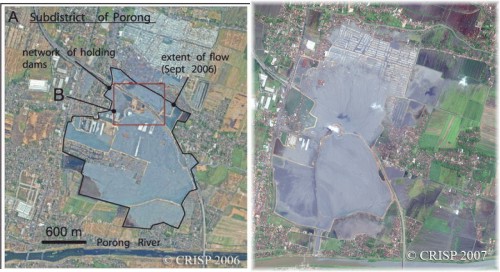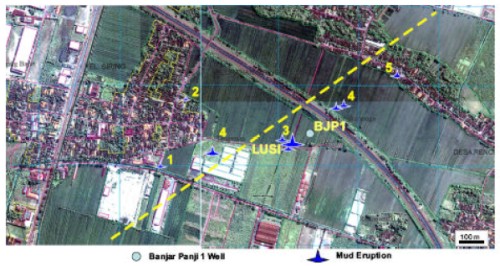The latest from Lusi
Regular readers of this blog should be aware of the mud volcano currently erupting in the Sidoarjo district in East Java, Indonesia, and the unsuccessful attempts to stem the flow by dropping concrete balls into the vent. Meanwhile, more and more villages, railways and factories are being engulfed, and tens of thousands of people displaced, by the encroaching mud. Just compare the image on the right below, taken at the beginning of June, to the one on the left, taken last September (source):

Obviously someone has to pay for the attempts at mitigation, no matter how hare-brained, and compensate those who have found their homes and livelihoods suddenly below ground level. Precisely who that someone should be has been the subject of a fair amount of legal wrangling between the Indonesian government and PT Lapindo Brantas, an exploration company who were drilling a gas well in the area at the time of the eruption. At first glance, it doesn’t look good for Lapindo Brantas: not only is the main vent of Lusi is a mere 200 m from their well, but it also turns out that the lower section of the borehole had not been ‘cased’, or sealed off from the surrounding rock with steel jacketing. In the paper which provided the background to my original post on Lusi, Richard Davies and his co-authors suggested that this lack of protection was directly responsible for the eruption: when the borehole penetrated a sealed limestone aquifer, it released a surge of high pressure water back up the drill hole, fracturing and mixing with the overlying mudstones and sending the a torrent of hot mud racing up to surface.
But there is a complication. Two days before Lusi erupted, a magnitude 6.3 earthquake hit central Java. Could this have had something to do with the eruption of Lusi? Davies et al. say no, but a paper in press in Earth and Planetary Science Letters argues otherwise – and thanks to the obvious legal ramifications, this little spat is getting a little bit of media attention. In this second paper, Adriano Mazzini, of the University of Oslo, and his colleagues* propose that shaking due to the earthquake weakened a fault which runs close to the Lusi vent, and it was this structure, not the borehole, that initially provided an escape route for the overpressured water. Their Figure 4, reproduced below, shows the location of the fault (dashed line) in relation to the borehole (BJP1) and all the mud eruptions in the area in the first week of activity.

This is interesting, and I can certainly see how the presence of this fault might have exacerbated matters. But it’s difficult to ignore the fact that even if teleseismic stresses acting on a buried fault did have a hand in triggering the eruption, of all the places Lusi could have erupted along that fault, it erupted at the closest possible point to a borehole which was not properly sealed, and therefore at high risk of blow-out. Could this be a coincidence? Mazzini et al. would have us believe so: they claim that the borehole had not penetrated down to the limestone aquifer at the time of the eruption (directly contradicting Davies et al.), and that, almost miraculously, the eruption has not registered in the borehole in any way at all:
no kicks [pressure fluctuations]. were recorded at the bottomhole of BJP1 [at the time of the eruption], and no fluids erupted through the well… Borehole tests showed that there was no connection between the fluids circulating in the well and mud erupted on surface.
Neither of these claims is supported by hard data in the paper, so where the two papers disagree on vital and important facts (particularly the depth attained and the timing and nature of pressure changes in the borehole), it is rather difficult to assess who is right. I have to say that regardless of the root cause of the eruption, the subsurface around the vent is probably now so pervasively fractured, and the borehole is such an obvious weak point, that it seems rather unlikely that you see no sign of the eruption in the borehole fluids. You’d also think that the eight experts consulted by the Indonesian police, who must surely have had access to the borehole records, would have been a bit less confident in implicating the drilling if this was the case. But then, when there are bills and blame to be assigned, the science is always going to be stretched to breaking point – especially since a law-suit demands a black-and-white answer to what may turn out to be a complicated question: ‘would Lusi have erupted, and erupted so spectacularly, if the Lapindo Brantas borehole been properly sealed?’. The answer to that may well be yes, even if the May 27th earthquake does prove to be a factor.
*one of whom appears to be an employee of Lapindo Brantas, hence the statement in the acknowledgement section that “The conclusions of this manuscript are not necessarily those of Lapindo Brantas & BPMIGAS, that did not influence the results of the presented research.” I see no reason to doubt this at this stage.
Categories: earthquakes, geohazards, geology, Lusi, paper reviews



Comments (1)